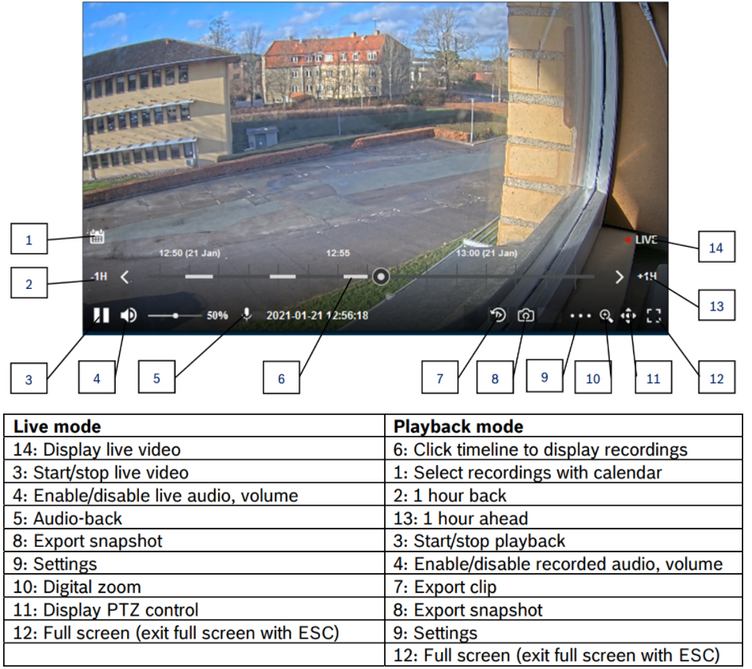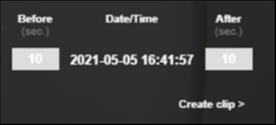- Top Results
- Bosch Building Technologies
- Security and Safety Knowledge
- Security: Video
- Alarm Management Configuration: How to set up a Live Intervention service?
Alarm Management Configuration: How to set up a Live Intervention service?
- Subscribe to RSS Feed
- Bookmark
- Subscribe
- Printer Friendly Page
- Report Inappropriate Content
Live Intervention Service

For vandalism & theft prevention.
IP-video surveillance cameras keep watch at your customer’s site, forwarding all device-generated alarms to your central station.
Your operators can verify all alarms through live and recorded video surveillance.
When immediate action is necessary, loudspeaker audio intervention enables operators to prevent damage.
Please follow below steps to set up a Live Intervention service.
Step-by-step guide
1. Configure the Live Intervention Service as Integrator or Config Agent:
To configure the Live Intervention service perform the following steps:
1.1 Add the camera to a Site
1. Open Alarm Management Configuration website (/config), log on as Integrator or Config Agent.
2. Enter the related Account - or create a new Account for the customer.
3. Enter the related Site - or create new Site.

4. Enable 'Video Clip Upload' if required. (If video clip upload is disabled, an alarm snapshot is stored).

5. Click '+' button to add the camera to this Site.
6. Please follow the related article to add a camera to Alarm Management:
Note: Not all below options are available for 3rd party cameras.
7. Rename the device (camera) and click 'Save Changes'.
8. Select the required trouble and tamper warnings, which should be sent to the Monitoring Center and click 'Save Changes'.

9. Click tab 'Channels' and set a Reference Image.

10. Rename the channel.
11. Select the device on which the microphone and loudspeaker are connected to (Associated Audio Device).

(Note: An audio device different form ‘Same Device’ is currently not supported for 3rd party cameras.)
12. Configure Audio Options for the Operator Interface (Investigation Mode):
a. 'Activate Audio Verification' allows the operator to listen to audio from the site.
b. 'Activate Audio Intervention' allows the operator to speak through the loudspeaker into the site.

13. Optional configure Video Options for the Operator Interface (Investigation Mode).

14. Click 'Save Changes'.
1.2 Configure Motion Detection (if not yet done by the Installer)
Please follow the related article to configure Motion Detection.
1.3 Configure Schedules
1. Open Alarm Management Configuration website (/config), log in as Integrator or Config Agent.
2. Enter the related Account.
3. Click tab 'Schedules' and modify the standard schedules 'Day', 'Night' and 'Weekend' if needed, or add new schedules.

Note: Blue cells mark active time periods. Cells can be altered by drawing the mouse.
1.4 Configure the Service Scenario
Note: A Service Scenario combines multiple cameras, triggers and alarm channels into one alarm.
1. Open Alarm Management Configuration website (/config), log in as Integrator or Config Agent.
2. Enter the related Account.
3. Click tab 'Services'.
4. Click '+' button to add a Service.
5. Select Service Type 'Live Intervention' and give the Service a descriptive name (mission).

6. Select the Site
7. Select the Triggering Device (camera) and then select the Triggering Event:
a. Physical Input: "Input Pin 1 - On"
b. Motion Detection
i. MOTION+ camera or 3rd party camera: "Channel 1 - Motion Triggered"
ii. Intelligent Video Analysis (IVA) or Essential Video Analytics (EVA):
a. "Channel 1 - VCA Event1" to "Channel 1 - VCA Event8" (each VCA Event is triggered by the related activated 'Surveillance Task' 1 to 8 in VCA configuration)
b. "Channel 1 - Motion Triggered" (merging motion trigger for all activated VCA Events)
c. Audio Alarm: "Audio Input 1 - Triggered"
d. etc.
8. Select the Alarm Channel

Notes:
- The Alarm Channel is used as the default video input channel for the alarm agent and uploads the alarm video clip (if available and configured for the camera and the service).
- If the trigger already implies an alarm channel (e.g. motion, VCA), the alarm channel is fixed and cannot be changed. In all other cases the alarm channel can configured to any channel of this site.
9. Optional add further triggers. The Service Scenario is triggered if any of the configured triggering events becomes activated.

10. Optional increase the Trigger Debounce Time (= minimum time between 2 alarms) if you want to get less alarms from this service.

11. Select the Arming Period (standard schedule, self-defined schedule, always).
12. Optional enter a Service Identifier.

This identifier can be used in the alarm management software to link the service scenario to a live intervention scenario from the same area.
13. Check "Enable event batching" to get all events in one batch.

14. Optional add Automatic Actions, which are executed automatically when the event is processed.

15. Optional add Intervention Actions, which can be manually executed by the operator in the Investigation Mode, e.g. play sound, send e-mail, etc.

16. Click 'Create'.
1.5 Configure the Site's Map
1. Open Alarm Management Configuration website (/config), log in as Integrator or Config Agent.
2. Enter the related Account.
3. Enter the related Site.
4. Click tab 'Map'
5. Drag and draw all cameras of this site into the map and turn the camera icons' arrow in the correct direction.

6. Click 'Save Changes'.
2. Verify the Live Intervention event as Alarm Agent
To verify the Live Intervention service perform the following steps:
1. Open Alarm Management Event list website (/eventmonitor), log in as Alarm Agent.
2. Ask customer to trigger the alarm (for example walk in front of the camera, push the button, etc.).
3. Click the new line appearing in the event list, the Operator Interface opens.

4. Verify the alarm:
a. Verification Mode:
i. Alarm image and video clip

b. Investigation Mode:
i. Live video
ii. Test Audio Verification (listen to site) and Audio Intervention (click microphone button to speak to the site).
iii. Optional perform Intervention Actions in 'Actions' field.

5. For 3rd party cameras, the HTML5 Video Control provides the following functionality for live video and playback in the Investigation Mode:

Live mode details:
4: Enable Audio Verification from the camera and control the volume.

5: Enable and confirm audio-back to perform Audio Intervention.
- Audio Intervention disabled:
- Audio Intervention enabled:
> allow audio-back:

9: Settings:

- Preferred format:
- WebRTC: low delay (UDP)
- for audio and PTZ control
- might be not available in corporate network - HLS: bit-rate adaptive streaming (TCP)
- no audio, no PTZ control - JPEG: JPEG polling
- WebRTC: low delay (UDP)

- Dewarping
- Off
- On (e.g. for fisheye camera)
11: Display in-window PTZ control

Playback mode details:
1: Calendar:
- Days with recordings are displayed in a circle
- Click to select the date

4: Enable audio playback from the recordings and control the volume.
7: Select pre- and post alarm recording to be exported.

9: Settings:
- Speed:
- Replay speed

Note that a Live Intervention alarm is only forwarded to the Alarm Management Event list and to the Monitoring Center when the site is armed and the arming schedule is active.
A Live Intervention alarm is not processed when the Maintenance Mode is enabled for the related Site, or when this service is snoozed.
See also the article Troubleshooting Alarm Notification in Operator Interface if no alarm appears in the event list.
Still looking for something?
- Top Results